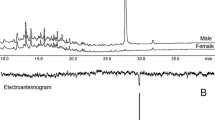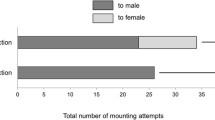Abstract
The reproductive behavior of the stink bug Chlorochroa sayiwas studied in the laboratory. There was a sexual maturation period of about 10 days before bugs began mating. Sexually mature adult bugs engaged in courtship consisting of antennation and head-butting of the female by the male, before the female adopted a receptive posture and copulation occurred. Both sexes mated multiple times during their life-spans, with the mean duration of copulations of virgin bugs (42.3 ± 19.6 min) and experienced bugs (37.3 ± 28.4 min) being similar. Most matings were initiated in the late afternoon or evening, when pheromone production by males was greatest. Males transferred sperm and nutrients constituting about 17% of their body weight to females during mating. Three male-specific components, methyl geranate, methyl citronellate, and methyl (E)-6-2,3-dihydrofarnesoate in a ratio of 100 : 0.45 : 1.6, were first detected in volatiles collected from male bugs on green beans about 9–12 days after the final molt to the adult stage. In vertical Y-tube bioassays, females were attracted to odors from mature male bugs, and to a blend of the three male-produced components. Low numbers of females also were attracted in field trials with the three-component blend. The relatively weak attraction may be a result of other, as yet unknown cues being required in addition to the pheromone, such as visual or substrate-borne vibrational cues.
Similar content being viewed by others
REFERENCES
AHLQUIST, L., and STäLLBERG-STENHAGEN, S. 1971. Studies on natural odoriferous compounds III. Synthesis of (+)-and (-)-3,7,11-trimethyl-6-trans,10-dodecadien-1-ol. Acta Chem. Scand.25:1685-1694.
ALDRICH, J. R. 1995. Chemical communication in the true bugs and parasitoid exploitation. pp. 318-363, inR. Card´e and W. Bell (eds.). Chemical Ecology of Insects 2, Chapman & Hall, New York.
ALDRICH, J. R., OLIVER, J. E., LUSBY, W. R., KOCHANSKY, J. P., and LOCKWOOD, J.A. 1987. Pheromone strains of the cosmopolitan pest, Nezara viridula(Heteroptera: Pentatomidae). J. Exp. Zool.244:171-175.
ALDRICH, J. R., HOFFMANN, M. P., KOCHANSKY, J. P., LUSBY, W. R., EGER, J. E., and PAYNE, J. A. 1991. Identification and attractiveness of a major pheromone component for Nearctic Euschistusspp. stink bugs (Heteroptera: Pentatomidae). Environ. Entomol.20:477-483.
ALDRICH, J. R., NUMATA, H., BORGES, M., BIN, F., WAITE, G. K., and LUSBY, W. R. 1993. Artifacts and pheromone blends from Nezaraspp. and other stink bugs (Heteroptera: Pentatomidae). Z. Naturforsch. 48C:73-79.
ALDRICH, J. R., OLIVER, J. E., LUSBY, W. R., KOCHANSKY, J. P., and BORGES, M. 1994. Identification of male-specific volatiles from Nearctic and Neotropical stink bugs (Heteroptera: Pentatomidae). J. Chem. Ecol.20:1103-1111.
BAKER, R., BORGES, M., COOKE, N. G., and HERBERT, R. H. 1987. Identification and synthesis of (Z)-(10S;30R;40S)-(¡)-2-(30;40-epoxy-40-methylcyclohexyl)-6-methyl-hepta-2,5-diene, the sex pheromone of the southern green stink bug, Nezara viridula(L.). J. Chem. Soc., Chem. Commun.1987:414-416.
BERGSTRöM, G., BERGMAN, P., APPELGREN, M., and SCHMIDT, J. O. 1996. Labial gland chemistry of three species of bumblebees (Hymenoptera: Apidae) from North America. Bioorg. Med. Chem.4:515-519.
BIONDINI, M. E., BONHAM, C. D., and REDENTE, E. F. 1985. Secondary successional patterns in a sagebrush (Artemisia tridentata) community as they relate to soil disturbance and soil biological activity. Vegetatio60:25-36.
BORGES, M., and ALDRICH, J. R. 1994. An attractant pheromone for the Nearctic stink bug, Euschistus obscurus(Heteroptera: Pentatomidae): Insight into a Neotropical relative. J. Chem. Ecol.20:1095-1102.
BORGES, M., JEPSON, P. C., and HOWSE, P. E. 1987. Long-range mate location and close range courtship behaviour of the green stink bug, Nezara viridulaand its mediation by sex pheromones. Entomol. Exp. Appl.44:205-212.
BORGES, M., MORI, K., COSTA, M. L. M., and SUJII, E. R. 1998a. Behavioural evidence of methyl-2,6,10-trimethyltridecanoate as a sex pheromone of Euschistus heros(Heteroptera: Pentatomidae). J. Appl. Entomol.122:335-338.
BORGES, M., SCHMIDT, F. G. V., SUJII, E. R., MEDEIROS, M. A., MORI, K., ZARBIN, P. H. G., and FERREIRA, J. T. B. 1998b. Field responses of stink bugs to the natural and synthetic pheromone of the Neotropical brown stink bug, Euschistus heros(Heteroptera: Pentatomidae). Physiol. Entomol.23:202-207.
BRéZOT, P., MALOSSE, C., MORI, K., and RENOU, M. 1994. Bisabolene epoxides in sex pheromone in Nezara viridula(L.) (Heteroptera: Pentatomidae): role of cisisomer and relation to specificity of pheromone. J. Chem. Ecol.20:3133-3147.
BRIEGER, G. 1971. Juvenile hormone mimics: Structure-activity relationships for Oncopeltus fasciatus. J. Insect Physiol.17:2085-2093.
CAMPBELL, P. E., OAKESHOTT, J. G., and HEALY, M. J. 1998. Purification and kinetic characterisation of juvenile hormone esterase from Drosophila melanogaster. Insect Biochem. Mol. Biol.28:501-515.
CAFFREY, D. J., and BARBER, G.W. 1919. The Grain Bug. Bulletin No. 779, June 1919, United States Department of Agriculture, Bureau of Entomology, Washington, DC.
ÇOKL, A., MCBRIEN, H. L., and MILLAR, J. G. 2001. Comparison of substrate-borne vibrational signals of two stink bug species, Acrosternum hilare(Say) and Nezara viridula(L.) (Heteroptera: Pentatomidae). Ann. Entomol. Soc. Am.in press.
DING, J., YU, X., DING, Z., CHENG, B., YI, Y., WU, Y., NANAO, H., and HISASHI, K. 1994. Essential oils of some Lauraceaespecies from the southwestern parts of China. J. Essent. Oil Res.6:577-585.
ERMAN, W. F., WENKERT, E. and JEFFS, P. W. 1969. Base cleavage of β, γ-unsaturated bicyclic cyclobutanones. J. Org. Chem.3:2196-2203.
EVANS, C. E., STADDON, B. W., and GAMES, D. E. 1990. Analysis of gland secretions of Pentatomoidea (Heteroptera) by gas chromatography-mass spectrometry techniques, pp. 321-328 inA. R. McCaffery, and I. D. Wilson (eds.). Chromatography and Isolation of Insect Hormones and Pheromones. Plenum Press, New York.
FISH, J., and ALCOCK, J. 1973. The behavior of Chlorochroa ligata(Say) and Cosmopepla bimaculata(Thomas) (Hemiptera: Pentatomidae). Entomol. News84:260-268.
FLATH, R. A., JANG, E. B., LIGHT, D. M., MON, T. R., CARVALHO L., BINDER, R. G., and JOHN, J. O. 1993. Volatile pheromonal emission from the male Mediterranean fruit fly: Effects of fly age and time of day. J. Agric. Food Chem.41:830-837.
FUJISAWA, T., SATO, T., KAWARA, T., NODA A., and OBINATA, T. 1980. A novel method for terpene synthesis by the ring-opening reaction of β-methyl-β-propiolactone. Tetrahedron Lett.21:2553-2554.
HARRIS, V. E., and TODD, J. W. 1980. Male-mediated aggregation of male, female and 5th-instar southern green stink bugs and concomitant attraction of a tachinid parasite, Trichopoda pennipes. Entomol. Exp. Appl.27:117-126.
HO, H.-Y. 2000. Studies on the sex pheromones of the pentatomid bugs Chlorochroa ligata, Chlorochroa sayi, and Chlorochroa uhleri, and the mirid bug Lygus hesperus(Hemiptera: Heteroptera). PhD thesis. University of California, Riverside, 236 pp.
HO, H.-Y., and MILLAR, J. G. 2000. Compounds in the metathoracic glands of adults and the dorsal abdominal glands of nymphs of the stink bugs Chlorochroa uhleri, C. sayiand C. ligata(Hemiptera: Pentatomidae). Zool. Stud.in press.
HOFFMANN, M. P.,WILSON, L. T., and ZALOM, F. G. 1987. Control of stink bugs in tomatoes. Calif. Agric.May-June:4-6.
HUFFER, M., and SCHREIER, P. 1990. High resolution gas chromatographic resolution of chiral primary alcohols and acids as their diastereomeric 1-phenylethylamides. J. Chromatogr.519:263-267.
JAMES, D. G., MORI, K., ALDRICH, J. R., and OLIVER, J. E. 1994. Flight-mediated attraction of Biprorulus bibaxBreddin (Hemiptera: Pentatomidae) to natural and synthetic aggregation pheromone. J. Chem. Ecol.20:71-80.
JAMES, D. G., HEFFER, R., and AMAIKE, A. 1996. Field attraction of Biprorulus bibaxBreddin (Hemiptera: Pentatomidae) to synthetic aggregation pheromone and (E)-2-hexenal, a pentatomid defense chemical. J. Chem. Ecol.22:1697-1708.
JANG, E. B., LIGHT, D. M., FLATH, R. A., NAGATA, J. T., and MON, T. R. 1989. Electroantennogram responses of the Mediterranean fruit fly, Ceratitis capitatato identified volatile constituents from calling males. Entomol. Exp. Appl.50:7-19.
KASULE, F. K. 1986. Repetitive mating and female fitness in Dysdercus cardinalis(Hemiptera: Pyrrhocoridae). Zool. J. Linn. Soc.88:191-199.
KOCIEÑSKI, P., and WADMAN, S. 1989. A highly stereoselective and iterative approach to isoprenoid chains: Synthesis of homogeraniol, homofarnesol, and homogeranylgeraniol. J. Org. Chem.54:1215-1217.
KONN, M., OE, A., NUMATA, H., and HIDAKA, T. 1988. Comparison of the mating behavior between two sympatric species, Nezara antennataand N. viridula(Heteroptera: Pentatomidae), with special reference to sound emission. J. Ethol.2:91-98.
LARUE, J. H., and JOHNSON, R. S. (eds.). 1989. Peaches, plums, and nectarines. Growing and handling for the fresh market. University of California,DANRpublication 3331; UCPublications, Oakland, California.
LEAL, W. S., KUWAHARA, S., SHI, X., HIGUCHI, H., MARINO, C. E. B., ONO, M., and MEINWALD, J. 1998. Male released sex pheromone of the stink bug Piezodorus hybneri. J. Chem. Ecol.24:1817-1829.
LEE, E. R., LAKOMY, I., BIGLER, P., and SCHEFFOLD, R. 1991. Reductive radical cyclizations of bromo acetals and (bromomethyl)silyl ethers of terpenoid alcohols. Helv. Chim. Acta74:146-162.
MAU, R. F. L., and MITCHELL, W. C. 1978. Development and reproduction of the oriental stink bug Plautia stali(Hemiptera: Pentatomidae). Ann. Entomol. Soc. Am.71:756-757.
MCBRIEN, H. L., and MILLAR, J. G. 1999. Phytophagous bugs, pp. 277-304, inJ. Hardie and A. K. Minks (eds.). Pheromones of Non-Lepidopteran Insects Associated with Agricultural Plants, CAB International, Wallingford, UK.
MCCUNE, B., and MEFFORD, M. J. 1999. PC-ORD. Multivariate Analysis of Ecological Data, Version 4. MjM Software Design, Gleneden Beach, Oregon, http://www.ptinet.net/~mjm
MCMURRY, J. E., and BOSCH, G. K. 1987. Synthesis of macrocyclic terpenoid hydrocarbons by intramolecular carbonyl coupling: bicyclogermacrene, lepidozene, and casbene. J. Org. Chem.52:4885-4893.
MCPHERSON, J. E., and MCPHERSON, R. M. 2000. Stink Bugs of Economic Importance in America North of Mexico. CRC Press, Boca Raton, Florida.
METCALF, R. L., and METCALF, R. A. 1993. Destructive and Useful Insects. Their Habits and Control. McGraw-Hill, New York.
MILLAR, J. G. 1997. Methyl (2E;4Z;6Z)-deca-2,4,6-trienoate, a thermally unstable, sex-specific compound from the stink bug Thyanta pallidovirens. Tetrahedron Lett.38:7971-7972.
MITCHELL, W. C., and MAU, R. F. L. 1969. Sexual activity and longevity of the southern green stink bug Nezara viridula. Ann. Entomol. Soc. Am.62:1246-1247.
MORRILL, A. W. 1910. Plant-bugs injurious to cotton bolls. U.S.D.A. Bur. Entomol. Bull.86:23-73.
NAGANO, H., NAGASAWA, T., and SAKUMA, M. 1997. Synthesis of 2-polyprenyl-substituted polyprenols and their conversion into phosphates. Bull. Chem. Soc. Jpn.70:1969-1976.
OEHLSCHLAGER, A. C., SINGH, S. M., and SHARMA, S. 1991. Squalene synthetase inhibitors: Synthesis of sulfonium ion mimics of the carbocationic intermediates. J. Org. Chem.56:3856-3861.
OHLENDORF, B. 1990. UC IPM Pest Management Guidelines. University of California Statewide Integrated Pest Management Project, University of California, Davis; Division of Agriculture and Natural Resources, publication 3339.
OTA, D., and ÇOKL, A. 1991. Mate location in the southern green stink bug, Nezara viridula(Heteroptera: Pentatomidae) mediated through substrate-borne signals in ivy. J. Insect Behav.4:441-447.
PANIZZI, A. R. 1997. Wild hosts of pentatomids: Ecological significance and role in their pest status on crops. Annu. Rev. Entomol.42:99-122.
RAO, C. G. 1980. A new rapid esterification procedure utilizing exceptionally mild reaction conditions. Org. Prep. Proc. Int.12:225-228.
RUSSELL, E. E. 1952. Stink bugs on seed alfalfa in southern Arizona. Circular No. 903, July. United States Department of Agriculture, Washington, DC. RYAN, M. A., and WALTER, G. H. 1992. Sound transmission in Nezara viridula(L.) (Heteroptera: Pentatomidae): Further evidence that signal transmission is substrate-borne. Experientia48:1112-1115. SATO, T., KAWARA, T., KAWASHIMA, M., and FUJISAWA, T. 1980. Copper-catalyzed reaction of Grignard reagents with β-propiolactones: A convenient method for the synthesis of β-substituted propionic acids. Chem. Lett.1980:571-574. SCHRADER, F. 1960. Evolutionary aspects of aberrant meiosis in some Pentatomidae (Heteroptera). Evolution14:498-508. SHIELDS, E. J. 1989. Artificial light: Experimental problems with insects. Bull. Entomol. Soc. Am.00:40-44. STRONG, F. E., SHELDAHL, J. A., HUGHES, P. R., and HUSSEIN, E. M. K. 1970. Reproductive biology of Lygus hesperusKnight. Hilgardia40:105-147. SUGIE, H., YOSHIDA, M., KAWASAKI, K., NOGUCHI, H., MORIYA, S., TAKAGI, K., FUKUDA, H., FUJIIE, A., YAMANAKA, M., OHIRA, Y., TSUTSUMI, T., TSUDA, K., FUKUMOTO, K., YAMASHITA, M., and SUZUKI, H. 1996. Identification of the aggregation pheromone of the brown-winged green bug, Plautia staliScott (Heteroptera: Pentatomidae). Appl. Entomol. Zool.31:427-431. TAMAO, K., and ISHIDA, N. 1984. Silafunctional compounds in organic synthesis. 27. (Isopropoxydimethylsilyl) methyl Grignard reagent: A novel nucleophilic hydroxymethylating agent for aldehydes and ketones. Tetrahedron Lett.25:4245-4248. TOSCANO, N. C., and STERN, V. M. 1976. Dispersal of Euschistus conspersusfrom alfalfa grown for seed to adjacent crops. J. Econ. Entomol.69:96-98. WANG, Q., and MILLAR, J. G. 1997. Reproductive behavior of Thyanta pallidovirens(Heteroptera: Pentatomidae). Ann. Entomol. Soc. Am.90:380-388. YAMATSU, I., YUICHI, I., SHINYA, A., WATANABE, H., IGARASHI, T., SHIOJIRI, H., TANABE, Y., and KUNIKO, H. 1981. β, β-Dihydropolyprenyl derivatives, pharmacological preparations containing them and method for treating liver diseases. Eur. Pat. Appl. EP41,235.
Author information
Authors and Affiliations
Rights and permissions
About this article
Cite this article
Ho, HY., Millar, J.G. Identification and Synthesis of a Male-Produced Sex Pheromone from the Stink Bug Chlorochroa sayi. J Chem Ecol 27, 1177–1201 (2001). https://doi.org/10.1023/A:1010368013235
Issue Date:
DOI: https://doi.org/10.1023/A:1010368013235




